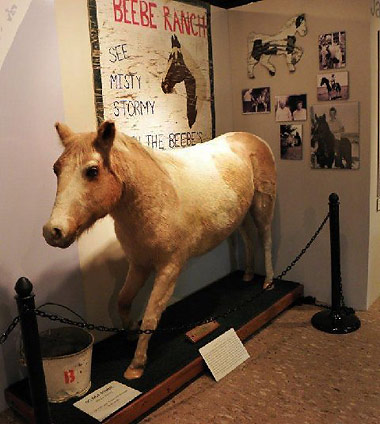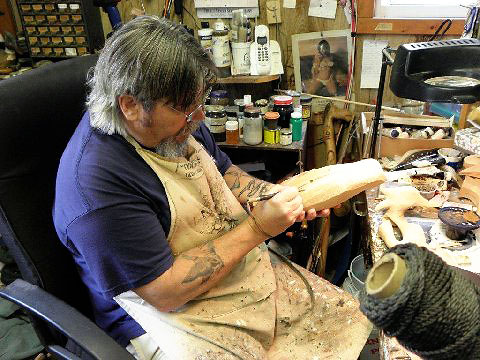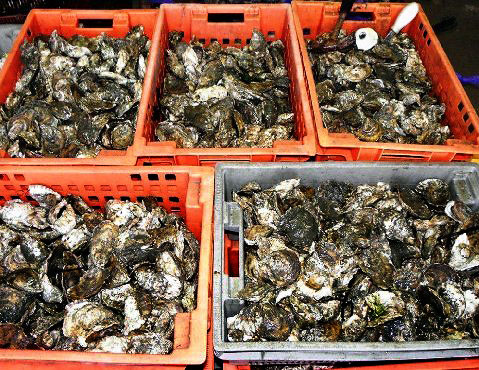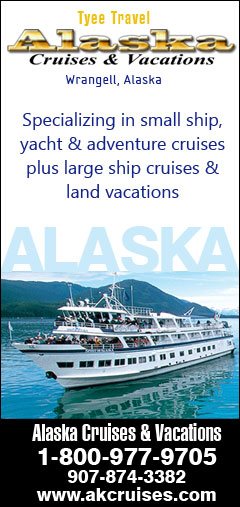 |
 |
|
 |

|
Chincoteague and
Assateague: Islands that Cling to a Colorful Past
Story by Fyllis Hockman Photos by Victor Block (except when otherwise indicated)
There are two major stories with which the ponies are involved. The first is the one made world-famous by book and movie, Misty of Chincoteague, written by Marguerite Henry in 1947 and depicted on screen in 1961; the second is the annual Pony Penning and Auction the last weekend in July which draws more than 40,000 visitors to the little island. But more about that later.
Seven-mile-long Chincoteague (pronounced shink-a-tig by the locals), a very Misty-centric town, is a throwback to an earlier seafaring era where decoy-carving was the primary obsession second only to the netting of oysters by local watermen. The Chincoteague Museum is a testament to all three components of the area's history. Originally opened in 1972 as the Oyster Museum to preserve the island's rich history of and connection to the sea, it was expanded in 2010 to reflect the more complex history of the region. Included also is an exhibition of stuffed birds who inhabit the island and carved decoys that represent the extensive duck and waterfowl hunting industry. Primitive decoys that famed carver Miles Hancock sold for $25 a dozen in the 1940's are now worth $1400 apiece.
And Misty herself is now front and center and dutifully stuffed, along with her foal Stormy, so named because he was born during the hurricane of 1962 which devastated the island and changed its commercial trajectory from industry to tourism with the building of a bridge that connected Chincoteague to Assateague's wild ponies and extensive beaches. Ponies, decoys and oysters -- I spoke to representatives of these three industries which define these two hitched-at-the-hip islands. Since the mid-1920's the local firemen have sold off the wild foals for money to buy much needed equipment, but it was not until that bridge was built did the auction become a major tourist attraction. But this is no ordinary auction. Remember these are wild ponies who spend their days in rough conditions, dining on saltwater marsh and other undesirable feed. According to "saltwater cowboy" Harry Thornton, so called because he's one on 45 elite firemen who round up the 150 horses each July, swim them over to Chincoteague, and gather them again on shore for the parade to the auction grounds, "Most horses, raised on hay and grains, couldn't last six months under the harsh conditions of Assateague, which is why the "ponies" (really little horses) rarely exceed 14 ½ hands in height." Chincoteague is now an officially recognized breed of horse, smaller than usual, but unusually hardy, intelligent and athletic.
Foals sold range in age from 5-12 weeks and if too young to be separated from their mothers they are kept on the island until October when they are sufficiently weaned to go to their new owners. Some of the mares balk at returning to Assateague without their young, and it can be heart-breaking to see. Most of the foals are sold off although some -- the pick of the litter so to speak -- are "buy backs" in order to replenish the herd. So say the "Buy-Back Babes," a group of women from all over the country who come every year and buy one foal to donate back to the herd -- and they come to visit it several times a year.
Indeed the ponies of Assateague are the great attraction. After all, that's where the real Misty was born and where several of her descendants roam today, although she also has relatives living on Chincoteague. The Beebe Ranch which was the setting for Henry's book is where Misty once lived and where Angel, Misty's great-great-grand foal, still resides. And there are many ways to view the horses: boat tours around Assateague; the Chincoteague Pony Center on Chincoteague, viewing areas at the Chincoteague National Wildlife Refuge on Assateague, and at the Refuge Inn, which houses its own small herd, on Chincoteague (yes, it's confusing -- I gave up trying to figure out what was where about halfway through my visit). But the most up-close-and-personal connection with entire bands of ponies is provided by the Chincoteague National Wildlife Refuge bus tour on Assateague. The knowledgeable guide takes you close enough to see the foals nursing, while regaling listeners with tales of the ponies' individual histories, their families, whom they hang out with, their idiosyncrasies and peccadilloes. Woeful Willy, for example, a somewhat depressed-looking pony, hangs out alone. Wanton Rambling Rose, on the other hand, "keeps company" with several stallions. A dark tan horse with an unkempt blond mane is known as, what else, Surfer Dude. The lives of the ponies unfold like an ongoing soap opera! Although Misty may be the island's most famous resident, there are several local decoy carvers who are also well known, though perhaps within a smaller circle of fans. Roe Terry is one of them. With his front-lawn sign announcing his approach to working -- "Open when I'm here, closed when I ain't" -- the DucMan, as he is known, has been carving decoys for 45 years. The history of decoy carving is as interesting in its own way as the tale of the ponies. Working decoys go back hundreds of years to the 1800's when they were used to lure ducks for hunting. Once manufactured plastic decoys -- cheaper but just as effective -- were introduced in the 1960's, the hand-made working decoys were priced out of the market. Over time, their value increased as they became collectors' items. Some carvers then started specializing in the decoy as decorative art: emphasizing raised wing tips, burning each feather individually into the wood with fine detailing and artistic painting. There is a definite hierarchy in the decoy-carving world. The primitive are those used for hunting dating back to the 1940's; working decoys today have keels and weights to make them right themselves in the water as ducks would and are painted but fairly basically so. The decorative decoys are an art form of the last 30 years.
And Roe has been a part of it at every level. When he was 15, a friend whose father was a prodigious carver gave him a decoy -- and he replicated it. That hooked him and soon he was selling them at a local restaurant, thinking, "Man this is easy money from just a block of wood." In 1974, he sold a large pair of flying mallards for $15 a pair; now they'd be worth $200 each. Not exactly in Miles Hancock's category, but up there.
As a competitive carver, he has won over 300 awards over 30 years. "My competitors can look at my decoy and say 'Roe Terry made those' -- they recognize my style. That's very important." One of his earliest lessons as a carver? Make the bird cute and you're more likely to sell it. "After all," he asks whimsically, "which would you rather buy -- a big fat woman or a sexy girl in a mini-skirt?" Consequently, he makes sexy decoys.
The same does not hold true for oysters. Although lifetime waterman Mike McGee might disagree. As he explains, "I've worked on the water my whole life. I married at 16 and am still married to the same woman and still catching oysters. My love affair with the sea and my wife has continued to this day." The oyster-catching business, however, has changed a lot. No longer is Mike plying the waters in the arduous, back-breaking tasks of pulling in the oysters. Today he owns Chincoteague Shellfish Farms, part of the largest shellfish aquaculture companies in the eastern U.S. Chincoteague oysters are highly prized country-wide because of their high salt content due to their proximity to the ocean. The industry suffered a lot in the 60's and 70's due to a virus that had been introduced into the water, but now, McGee claims, they are better off than they were 50 years ago and the waters are once again "God's country for the oyster." Adds McGee: "But the watermen themselves are now the endangered species." Aquaculture -- growing the oysters on land and re-introducing them into the wild to mature under environmentally safe conditions -- has saved their lives.
Very old school, Mike claims to have never sent an email and boasts he knows every customer he's ever sold to. "I know their history, their kids, their hobbies." Not unlike the bus tour guide's approach to the ponies. "Sure I could modernize more, upgrade technologically," says Mike, "but I'm not going to put someone out of a job just to save a little money." Asked his favorite way to imbibe? "Raw and naked," he said. The ubiquitous sauce always served on the side? "Destroys the taste," he asserts. And as if to echo Mike's preferences and attest to the appeal of his latest haul, my husband, upon tasting one of Mike's prized catches, pronounced it, "The best oyster I've ever had in my life." So whatever native animal most inspires you -- the ponies to view, the oysters to eat, the duck decoys to adorn your mantel -- the islands of Chincoteague and Assateague won't disappoint. For more information, please visit www.chincoteaguechamber.com or call 757-336-6161. Related Articles: (Posted 10-13-2012) |
|
This site is designed and maintained by WYNK Marketing. Send all technical issues to: support@wynkmarketing.com

|

































